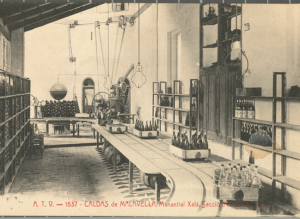Caldes en Temps de Guerres
Tourist Office – Programme
The town of Caldes de Malavella was involved, for good or for bad, in the great war events of the mid-20th century: the Spanish Civil War, the Second World War and the immediate post-war period. As stated in the first Caldes tourist guide (1927), the town offered a large number of beds and rooms in thermal spas, inns and around 30 chalets with different capacities. So, the centre had to accommodate large contingents of refugees from different areas, both civilians and soldiers. Their presence and interaction with locals, famous for their hospitable nature, led to all kinds of personal relations and memories that live on today.
Between 1936 and 1939, the republican authorities converted some of the thermal spas and holiday accommodation in Caldes into military hospitals and refugee collection points. During that period, when the population was approximately 2,200, up to 1,313 displaced persons were received. The Prats, Vichy and Soler Thermal Spas in particular were full of people from northern Spain, primarily Cantabria, the Basque Country and Aragón. A short time later (late 1937), Vichy Thermal Spa was opened as a campaign hospital to care for wounded soldiers. Soler Thermal Spa was converted into a recovery centre and the San José de Cluny College into a centre for infectious patients.
In 1944, it received over 1,000 Italian soldiers, who had been bombed by German planes once Italy had signed the armistice with the Allies. The Franco administration spread them out over the Vichy (497), Prats (195) and Soler (150) Thermal spas, but it was also necessary to use the Ribot Inn and Fabrellas Inn, which had 58 and 50 beds, respectively.
Once the Second World War was over, the Franco government received a community of almost 20,000 German refugees from all over the Spanish state, most of whom had worked for the Gestapo (political police), the Sicherheitsdienst (secret service), the Abwehr (military espionage) and at different diplomatic offices, dedicating a good part of their time to tasks involving espionage, counterespionage and sabotage against Spain, to serve the interests of the Nazi regime. Almost 100 Germans were accommodated in Caldes between the autumn of 1944 and the autumn of 1947. Some were on the priority repatriation lists issued by the Allies, but very few were handed over. Some were able to stay in their cities of origin in Spain under the protection of the Franco regime while others were able to move to Argentina and other countries in South America.






 By bike: 30 minutes
By bike: 30 minutes 5,3 miles
5,3 miles

